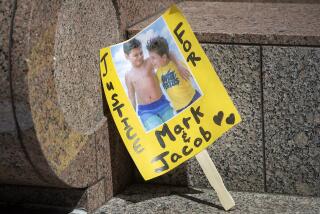Spector’s defense calls its last expert
- Share via
A final forensic expert testified for the defense at the Phil Spector murder trial Thursday, completing what lawyers have called the heart of the famous music producer’s fight to clear his name.
Testimony is expected to finish Monday, followed by a discussion of legal instructions the judge will give to the jury before it begins deliberations. Closing arguments by attorneys are expected to occur just after Labor Day.
Spector’s defense team of at least five lawyers confirmed Thursday that it has added another member: Dennis Riordan, a prominent San Francisco appellate attorney. The defense says Riordan is to assist the defense with proceedings on jury instructions.
Spector is accused of firing a snub-nosed revolver in the mouth of actress Lana Clarkson at his Alhambra home on Feb. 3, 2003.
Spector’s defense team contends that Clarkson, despondent over a fading acting career, her judgment impaired by alcohol, shot herself. Defense lawyers have argued that a scientific analysis of the death scene will clear Spector, by showing that he was standing too far from Clarkson to have held the gun in her mouth.
The prosecution, however, says blood spatters on Spector’s jacket that night showed that he fired the gun. Werner Spitz, a retired coroner and prominent forensic pathologist, was called to testify Thursday to support earlier testimony by another defense pathologist, Michael Baden, suggesting that Clarkson might have coughed blood onto Spector’s jacket as he rendered aid after she shot herself.
Baden surprised prosecutors last week with a new theory -- that Clarkson may not have died instantly, as her autopsy found. The autopsy showed Clarkson’s spinal cord was instantly severed by the bullet, preventing her from coughing or making any other movement.
Baden said the cord may have been only partly cut by the bullet, allowing Clarkson to briefly continue breathing, only to be completely severed when coroners moved her body.
Spitz, who also testified in July, said he now believes “there was damage to the spinal cord from the bullet, compounded by additional damage” caused when the coroner’s staff moved Clarkson’s body.
Spitz was called to rebut testimony by John Andrews, a neuropathologist for the prosecution.
Andrews said it was unlikely that Clarkson’s spinal cord remained partly intact because the diameter of the .38-caliber bullet was nearly the same as the section of spinal cord it hit, and the bullet struck the cord in its center. Spitz said Andrews used flawed estimates of the diameters of the bullet and of the spinal cord to make that point. But prosecutor Alan Jackson pointed out that Spitz, who in earlier testimony had said he was an expert in gunshot wounds, also used an incorrect figure for the bullet’s diameter. Spitz acknowledged the error.
The prosecutor and Spitz spent nearly all of Thursday’s court session arguing over the ability of brain impulses to control bodily functions after a spinal cord injury. Only one of the 12 jurors, most of whom normally take notes, had his pad open. That juror, an engineer, has diligently recorded the proceedings with the intensity of a court reporter.
The defense will conclude its case by calling friends of Clarkson, who are expected to testify about her alleged drug use or depression. Los Angeles County Superior Court Judge Larry Paul Fidler said he must read previous testimony by the witnesses to decide whether the statements they intend to make are repetitive.
--
More to Read
Sign up for Essential California
The most important California stories and recommendations in your inbox every morning.
You may occasionally receive promotional content from the Los Angeles Times.













